The half-frame oblique cameras market is expected to grow to USD 251.7 million in 2025 and is anticipated to reach USD 509.2 million by 2035, registering a CAGR of 7.3%. The Growth Rate Volatility Index (GRVI) for this market highlights moderate fluctuations in the early years. From 2020 to 2025, revenue grows from USD 177 million to USD 251.7 million, with annual growth rates ranging between 6.5% and 7.5%.
This indicates some volatility due to uneven adoption across industries such as defense, surveying, and urban development. The moderate variability in growth reflects a period of increasing experimentation with aerial mapping solutions, where early adopters are driving the majority of demand while the broader market is still adjusting.
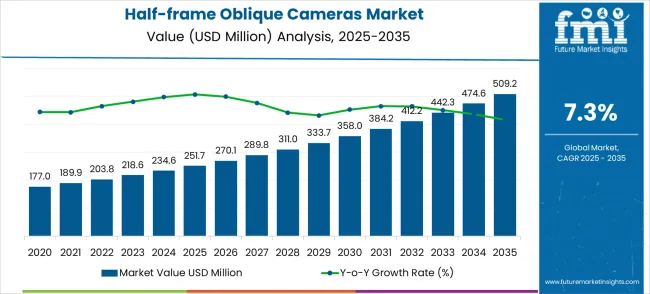
| Metric | Value |
|---|---|
| Market Value (2025) | USD 251.7 million |
| Market Forecast Value (2035) | USD 509.2 million |
| Forecast CAGR (2025-2035) | 7.3% |
During the mid-phase from 2025 to 2030, the market expands from USD 251.7 million to USD 358.0 million, with YoY growth stabilizing within the range of 7.0% to 7.3%. This indicates a lower GRVI compared to earlier years, suggesting more predictable adoption patterns. The reduced volatility is attributed to established procurement programs from governments, greater use in construction and infrastructure planning, and steady expansion in commercial geospatial applications. Manufacturers benefit from clearer demand visibility, while service providers gain consistency in project orders. This phase of the adoption lifecycle demonstrates market consolidation, where growth is driven not only by early adopters but also by broader mainstream users, reducing fluctuations in revenue generation.
From 2030 to 2035, revenue increases from USD 358.0 million to USD 509.2 million, and YoY growth hovers consistently around 7.2% to 7.4%. This stage of the GRVI indicates very low volatility, signaling that the market has matured and stabilized. Adoption is driven by standardized integration of oblique imaging into industries such as agriculture, environmental monitoring, and logistics. Repeat purchases and upgrades from existing users dominate demand, further smoothing fluctuations. The minimal variance in growth highlights a dependable expansion curve that offers stakeholders strong predictability in revenues. By 2035, the Half-frame oblique cameras market demonstrates high maturity, with demand locked into regular procurement cycles and regional adoption spreading more uniformly.
Market expansion is being supported by revolutionary advances in compact aerial imaging technology and cost-effective surveying solutions, creating unprecedented opportunities for accessible high-precision mapping and versatile aerial data collection optimization. Regional surveying companies and small-scale mapping applications increasingly demand sophisticated yet affordable oblique camera systems that deliver comprehensive angular perspectives, provide high-resolution imagery, and offer portable three-dimensional mapping capabilities for local infrastructure assessment and project monitoring. The integration of advanced compact sensor technology with streamlined image processing enables previously impossible levels of cost-effective mapping precision and portable aerial surveying capabilities.
The growing focus on democratized surveying technology and regional mapping development is driving massive demand for Half-frame oblique cameras from emerging surveying companies with proven expertise in cost-effective mapping solutions. Regional surveying firms and local government agencies are investing significantly in compact oblique imaging technologies that offer superior mapping value while providing enhanced accessibility and comprehensive area assessment through affordable aerial photography protocols. Regional surveying standards are establishing performance benchmarks that favor compact oblique camera systems with advanced imaging capabilities and superior cost-effectiveness features.
The regional surveying industry's transformation toward accessible aerial mapping is creating substantial demand for intelligent compact oblique camera products capable of delivering professional-grade mapping and surveying through portable aerial imaging platforms. The local mapping sector continues to drive innovation in cost-effective aerial applications while maintaining data accuracy and operational efficiency, leading to development of breakthrough compact oblique camera systems with enhanced portability capabilities and comprehensive regional surveying integration.
The market is segmented by resolution type, application, and region. By resolution type, the market is divided into 100 million pixels, 200 million pixels, 300 million pixels, and other configurations. Based on application, the market is categorized into drones, monitoring equipment, emergency rescue, surveying and mapping, and other applications. Regionally, the market is divided into North America, Europe, East Asia, South Asia & Pacific, Latin America, and Middle East & Africa.
200 million pixels resolution configurations are projected to account for 45% of the Half-frame oblique cameras market in 2025. This leading share is supported by explosive adoption of balanced resolution requirements and growing demand for optimal cost-performance aerial mapping through advanced compact sensor technology. 200-million-pixel Half-frame oblique cameras provide exceptional image quality and mapping accuracy while maintaining cost-effectiveness, making them the preferred choice for regional surveying professionals seeking comprehensive aerial data collection and high-precision mapping capabilities within budget constraints. The segment benefits from revolutionary advances in compact sensor technology, efficient image processing systems, and portable data storage solutions that have created entirely new categories of cost-effective high-resolution aerial imaging devices.
Modern 200-million-pixel Half-frame oblique cameras incorporate sophisticated compact image sensors and streamlined processing algorithms that enable real-time image capture, comprehensive angular coverage, and seamless integration with regional mapping software while ensuring superior image quality and efficient data collection. These innovations have transformed cost-effective aerial surveying while providing superior mapping capabilities for regional infrastructure assessment and local planning projects through continuous image acquisition and intelligent compact data processing. The regional surveying market particularly drives demand for 200 million pixel solutions, as these applications require optimal image detail and reliable data collection to deliver superior mapping outcomes and cost-effective surveying accuracy.
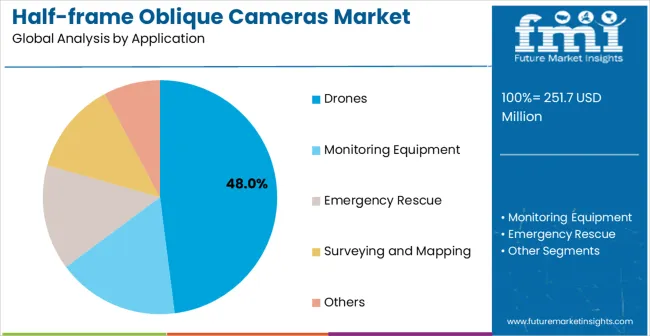
Drones applications are expected to represent 48% of Half-frame oblique cameras demand in 2025. This significant share reflects the massive small-scale unmanned aerial vehicle market for regional aerial surveying and growing investment in compact drone-based mapping technologies for local aerial data collection. Drone applications enable comprehensive regional aerial surveying through sophisticated compact oblique imaging, automated flight patterns, and efficient data collection systems optimized for smaller project scales. The segment benefits from breakthrough advances in compact drone technology that makes sophisticated regional aerial mapping accessible and critical for local surveying accuracy and cost-effective operational efficiency.
The regional drone revolution drives significant demand for compact drone-based oblique camera systems that provide exceptional aerial imaging capabilities and intelligent data collection for local surveying and mapping applications and regional infrastructure monitoring projects. These applications require compact oblique camera systems with superior imaging abilities and comprehensive small-scale drone integration to ensure reliable regional aerial data collection and effective local surveying project capabilities. The segment benefits from growing compact drone adoption in regional surveying applications and increasing implementation of cost-effective automated aerial mapping technologies and accessible surveying solutions.
Regional surveying and local government sectors contribute substantially to market growth as organizations implement compact drone-based oblique camera systems in local mapping projects and regional infrastructure monitoring strategies. The growing adoption of small-scale unmanned aerial surveying creates opportunities for specialized compact drone oblique camera systems designed for regional aerial mapping applications and comprehensive local surveying project management.
The Half-frame oblique cameras market is advancing steadily due to revolutionary compact aerial imaging technology development and unprecedented adoption of cost-effective drone-based surveying across all regional mapping and local infrastructure monitoring segments. However, the market faces challenges including resolution limitations compared to Full-frame systems, need for efficient data processing capabilities, and varying performance requirements across different compact aerial surveying applications. Regional aviation regulations and local data privacy standards continue to influence product development and market adoption patterns.
The revolutionary advances in compact sensor technology, efficient image processing algorithms, and automated lightweight flight systems are enabling unprecedented regional aerial mapping capabilities while maintaining cost-effectiveness and operational accessibility standards. Advanced compact imaging architectures and regional surveying-specific camera systems provide superior image quality and efficient data collection capabilities, enabling dynamic regional mapping optimization and enhanced local surveying accuracy. These technologies are particularly valuable for regional surveying applications that require sophisticated compact aerial imaging, accurate local data collection, and reliable cost-effective mapping standardization protocols.
Modern Half-frame oblique camera manufacturers are implementing breakthrough ecosystem integration and comprehensive regional surveying platform development that enables seamless local aerial data integration while supporting accessible mapping optimization and regional project management enhancement. Advanced compact platform architectures enable unified regional aerial imaging, efficient data processing, and local project management while ensuring cost-effective data accuracy compliance and regional surveying operational requirements.
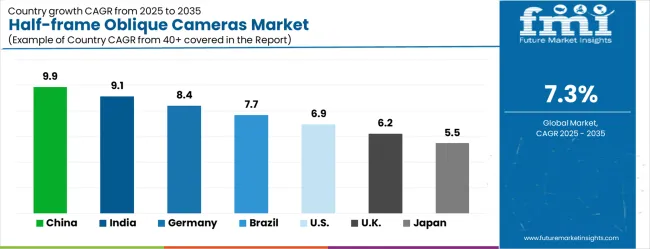
| Country | CAGR (2025-2035) |
|---|---|
| China | 9.9% |
| India | 9.1% |
| Germany | 8.4% |
| Brazil | 7.7% |
| United States | 6.9% |
| United Kingdom | 6.2% |
| Japan | 5.5% |
The Half-frame oblique cameras market is experiencing robust growth, with China leading at an impressive 9.9% CAGR through 2035, driven by massive regional infrastructure development and rapidly expanding cost-effective surveying technology adoption. India follows at 9.1%, supported by enormous local development potential and increasing accessible smart city infrastructure investment. Germany records strong growth at 8.4%, emphasizing regional surveying technology innovation excellence and advanced compact aerial imaging development. Brazil grows significantly at 7.7%, benefiting from expanding regional infrastructure projects and cost-effective surveying technology adoption. The United States shows solid growth at 6.9%, focusing on regional surveying technology advancement and compact mapping applications. The United Kingdom maintains steady expansion at 6.2%, supported by regional surveying innovation development. Japan demonstrates consistent growth at 5.5%, emphasizing precision compact imaging technology and regional surveying excellence.
The report covers an in-depth analysis of 40+ countries top-performing countries are highlighted below.
Revenue from Half-frame oblique cameras in China is projected to exhibit the highest growth rate with a CAGR of 9.9% through 2035, driven by the country's position as a regional infrastructure development powerhouse and massive domestic investment in accessible surveying technology advancement. The extensive regional construction projects and unprecedented investment in cost-effective mapping development are creating extraordinary opportunities for compact oblique camera technology adoption. Major regional surveying and compact drone companies are developing world-leading affordable aerial imaging capabilities to serve both the enormous domestic regional infrastructure market and global cost-effective surveying expansion while establishing leadership in accessible aerial mapping applications.
Revenue from Half-frame oblique cameras in India is expanding at a CAGR of 9.1%, supported by the country's massive local development potential and rapidly accelerating regional smart city infrastructure across all areas and development segments. The enormous regional infrastructure development projects and increasing cost-effective surveying technology adoption are driving extraordinary compact oblique camera system demand potential. Regional surveying technology companies are leveraging India's vast local development market while developing highly cost-effective aerial imaging solutions to capture emerging opportunities in regional urban planning and local infrastructure monitoring applications.
Demand for Half-frame oblique cameras in Germany is projected to grow at a CAGR of 8.4%, supported by the country's leadership in regional surveying technology innovation and advanced compact aerial imaging development across engineering, regional construction, and local geospatial sectors. German regional surveying technology companies are implementing sophisticated compact oblique camera development that meets stringent regional accuracy standards and local operational requirements while delivering superior compact imaging properties and cost-effective system reliability. The market is characterized by focus on regional surveying innovation, advanced compact technology integration, and compliance with comprehensive local data accuracy and regional operational efficiency regulations.
Revenue from Half-frame oblique cameras in Brazil is growing at a CAGR of 7.7%, driven by expanding regional infrastructure development and increasing cost-effective surveying technology investment across local and emerging regional construction market segments. The growing regional infrastructure awareness and increasing local surveying project development are creating substantial opportunities for compact oblique camera market development. Regional surveying technology companies are adapting compact aerial imaging systems to support growing local infrastructure demand and regional construction development while maintaining high cost accessibility and local market relevance.
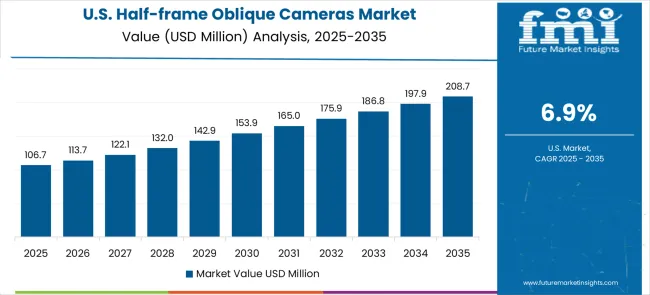
Demand for Half-frame oblique cameras in the United States is expanding at a CAGR of 6.9%, driven by the country's regional surveying technology advancement and local surveying market demand for advanced compact aerial imaging products and cost-effective mapping technologies. The sophisticated regional surveying infrastructure and local surveying willingness to invest in advanced compact oblique camera systems create significant demand for high-performance regional surveying solutions. The market benefits from breakthrough compact aerial imaging research and regional surveying-grade technology market segments across local government, regional commercial, and academic applications.
Demand for Half-frame oblique cameras in the United Kingdom is projected to grow at a CAGR of 6.2%, supported by ongoing regional surveying innovation advancement and increasing local surveying demand for intelligent compact aerial imaging products in regional infrastructure and local commercial surveying applications. Compact aerial imaging technology companies are investing in regional surveying technology development that provides advanced compact functionality while meeting local accuracy requirements and regional regulatory compliance for local surveying applications. The market is characterized by focus on regional surveying innovation, local data accuracy protection, and advanced compact technology integration across diverse regional surveying segments.
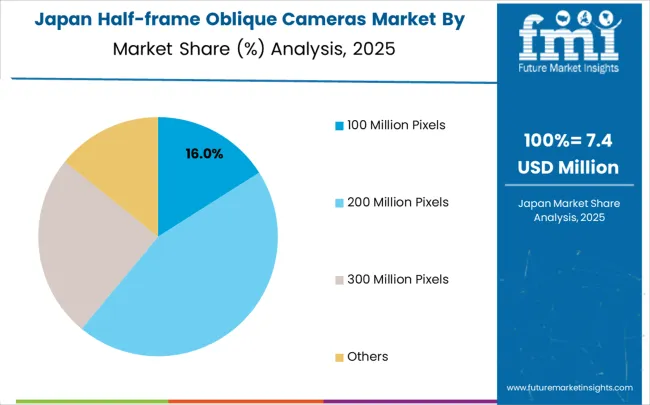
Demand for Half-frame oblique cameras in Japan is expanding at a CAGR of 5.5%, driven by the country's emphasis on compact aerial imaging technology excellence and precision regional surveying development across electronics, local construction, and regional geospatial sectors. Japanese compact aerial imaging technology companies are developing sophisticated compact oblique camera applications that incorporate precision engineering and regional surveying optimization principles. The market benefits from focus on compact imaging precision, technology reliability, and continuous innovation in regional surveying technology and local aerial mapping integration.
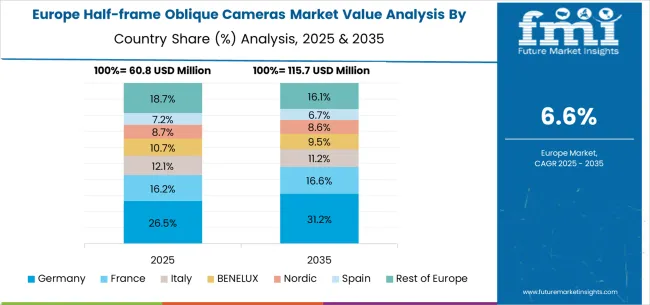
The Half-frame oblique cameras market in Europe is projected to grow from USD 67.4 million in 2025 to USD 136.4 million by 2035, registering a CAGR of 7.3% over the forecast period. Germany is expected to maintain its leadership with a 34.2% share in 2025, supported by its advanced regional surveying technology industry and compact aerial imaging excellence. The United Kingdom follows with 24.8% market share, driven by regional surveying innovation advancement and compact aerial imaging technology development. France holds 18.6% of the European market, benefiting from regional surveying technology expansion and compact aerial imaging industry development. Italy and Spain collectively represent 14.1% of regional demand, with growing focus on regional surveying development and compact aerial imaging technology applications. The Rest of Europe region accounts for 8.3% of the market, supported by compact aerial imaging technology development in Eastern European countries and Nordic regional surveying innovation advancement.
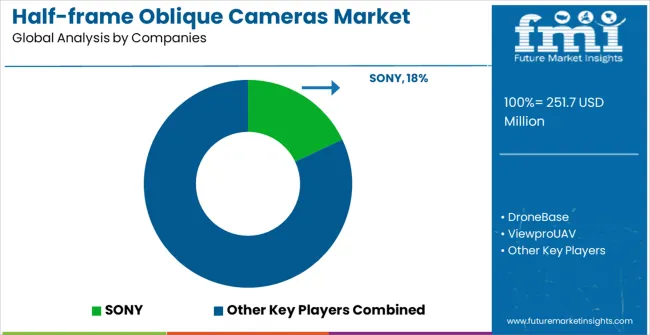
The Half-frame oblique cameras market is defined by moderate competition among compact imaging technology providers, innovative regional surveying companies, and established cost-effective drone equipment manufacturers. Companies are investing in compact aerial imaging research and development, advanced camera design, regional imaging accuracy validation, and local surveying ecosystem integration to deliver revolutionary, reliable, and cost-effective oblique camera products. Strategic partnerships, technological advancement, and steady regional surveying market expansion are central to achieving market leadership and local surveying adoption.
SONY, operating globally, offers comprehensive compact aerial imaging solutions with focus on regional and commercial applications, cost-effective imaging performance optimization, and seamless local surveying integration across compact camera systems, imaging sensors, and regional surveying services applications. DroneBase, technology provider, delivers advanced regional aerial surveying services with emphasis on local surveying reliability, compact imaging performance, and intelligent regional aerial mapping capabilities. ViewproUAV provides innovative compact drone imaging systems with focus on comprehensive regional surveying integration and cost-effective aerial applications. SenseImage Technologies offers precision compact aerial imaging systems with advanced cost-effective oblique camera technology and regional surveying-grade performance capabilities.
ATL DRONE provides specialized compact aerial imaging systems with emphasis on regional surveying and local commercial applications. Quantum-Systems delivers advanced compact drone platforms with sophisticated regional aerial imaging and local surveying optimization capabilities. Phase One offers comprehensive compact camera solutions with regional aerial imaging integration and cost-effective surveying services. Arca-Swiss provides compact camera mounting systems with advanced regional surveying integration and local aerial imaging systems.
Cambo, JOUAV, SOUTH GNSS, Riebotech, Daspatial, Qianxun Spatial Intelligence, JAZZ Technology, Keweitai Enterprise, Huace Navigation Technology, SHAREUAV, and Geo-Vision Information offer specialized compact aerial imaging expertise, innovative product development, and technical advancement across cost-effective oblique camera and regional surveying technology networks.
The Half-frame oblique cameras market underpins regional aerial surveying revolution, cost-effective mapping technology advancement, accessible geospatial data democratization, and regional surveying optimization evolution. With accelerating compact drone adoption, cost-effective aerial imaging technology expansion, and regional data accuracy requirements, the sector faces pressure to balance innovation velocity, cost-effectiveness protection, and regional surveying performance validation. Coordinated contributions from governments, industry bodies, OEMs/technology integrators, suppliers, and investors will accelerate the transition toward beneficial, accurate, and universally accessible Half-frame oblique camera ecosystems.
| Item | Value |
|---|---|
| Quantitative Units | USD 251.7 million |
| Resolution Type | 100 Million Pixels, 200 Million Pixels, 300 Million Pixels, Others |
| Application | Drones, Monitoring Equipment, Emergency Rescue, Surveying and Mapping, Others |
| Regions Covered | North America, Europe, East Asia, South Asia & Pacific, Latin America, Middle East & Africa |
| Country Covered | United States, Germany, India, China, United Kingdom, Japan, Brazil, and other 40+ countries |
| Key Companies Profiled | SONY, DroneBase, ViewproUAV, SenseImage Technologies, ATL DRONE, Quantum-Systems, Phase One, Arca-Swiss, Cambo, JOUAV, SOUTH GNSS, Riebotech, Daspatial, Qianxun Spatial Intelligence, JAZZ Technology, Keweitai Enterprise, Huace Navigation Technology, SHAREUAV, Geo-Vision Information |
The global Half-frame oblique cameras market is estimated to be valued at USD 251.7 million in 2025.
The market size for the Half-frame oblique cameras market is projected to reach USD 509.2 million by 2035.
The Half-frame oblique cameras market is expected to grow at a 7.3% CAGR between 2025 and 2035.
The key product types in Half-frame oblique cameras market are 100 million pixels, 200 million pixels, 300 million pixels and others.
In terms of application, drones segment to command 48.0% share in the Half-frame oblique cameras market in 2025.






Our Research Products

The "Full Research Suite" delivers actionable market intel, deep dives on markets or technologies, so clients act faster, cut risk, and unlock growth.

The Leaderboard benchmarks and ranks top vendors, classifying them as Established Leaders, Leading Challengers, or Disruptors & Challengers.

Locates where complements amplify value and substitutes erode it, forecasting net impact by horizon

We deliver granular, decision-grade intel: market sizing, 5-year forecasts, pricing, adoption, usage, revenue, and operational KPIs—plus competitor tracking, regulation, and value chains—across 60 countries broadly.

Spot the shifts before they hit your P&L. We track inflection points, adoption curves, pricing moves, and ecosystem plays to show where demand is heading, why it is changing, and what to do next across high-growth markets and disruptive tech

Real-time reads of user behavior. We track shifting priorities, perceptions of today’s and next-gen services, and provider experience, then pace how fast tech moves from trial to adoption, blending buyer, consumer, and channel inputs with social signals (#WhySwitch, #UX).

Partner with our analyst team to build a custom report designed around your business priorities. From analysing market trends to assessing competitors or crafting bespoke datasets, we tailor insights to your needs.
Supplier Intelligence
Discovery & Profiling
Capacity & Footprint
Performance & Risk
Compliance & Governance
Commercial Readiness
Who Supplies Whom
Scorecards & Shortlists
Playbooks & Docs
Category Intelligence
Definition & Scope
Demand & Use Cases
Cost Drivers
Market Structure
Supply Chain Map
Trade & Policy
Operating Norms
Deliverables
Buyer Intelligence
Account Basics
Spend & Scope
Procurement Model
Vendor Requirements
Terms & Policies
Entry Strategy
Pain Points & Triggers
Outputs
Pricing Analysis
Benchmarks
Trends
Should-Cost
Indexation
Landed Cost
Commercial Terms
Deliverables
Brand Analysis
Positioning & Value Prop
Share & Presence
Customer Evidence
Go-to-Market
Digital & Reputation
Compliance & Trust
KPIs & Gaps
Outputs
Full Research Suite comprises of:
Market outlook & trends analysis
Interviews & case studies
Strategic recommendations
Vendor profiles & capabilities analysis
5-year forecasts
8 regions and 60+ country-level data splits
Market segment data splits
12 months of continuous data updates
DELIVERED AS:
PDF EXCEL ONLINE
Full-frame Oblique Cameras Market Size and Share Forecast Outlook 2025 to 2035
InGaAs Cameras Market by Technology, Scanning Type, Industry & Region Forecast till 2035
Network Cameras and Video Analytics Market Analysis – Trends & Forecast 2025 to 2035
Security Cameras (IR Illuminator) Market Size and Share Forecast Outlook 2025 to 2035
Aircraft Cameras Market Size and Share Forecast Outlook 2025 to 2035
Light Field Cameras Market Size and Share Forecast Outlook 2025 to 2035
Mobile Gamma Cameras Market Growth - Industry Trends & Forecast 2025 to 2035
Time Of Flight Cameras Market Size and Share Forecast Outlook 2025 to 2035
Embedded Smart Cameras Market Growth – Trends & Forecast 2023-2033
Wireless Surgical Cameras Market Size and Share Forecast Outlook 2025 to 2035
Medium Format Film Cameras Market Size and Share Forecast Outlook 2025 to 2035
Night Vision Surveillance Cameras Market Size and Share Forecast Outlook 2025 to 2035

Thank you!
You will receive an email from our Business Development Manager. Please be sure to check your SPAM/JUNK folder too.
Chat With
MaRIA